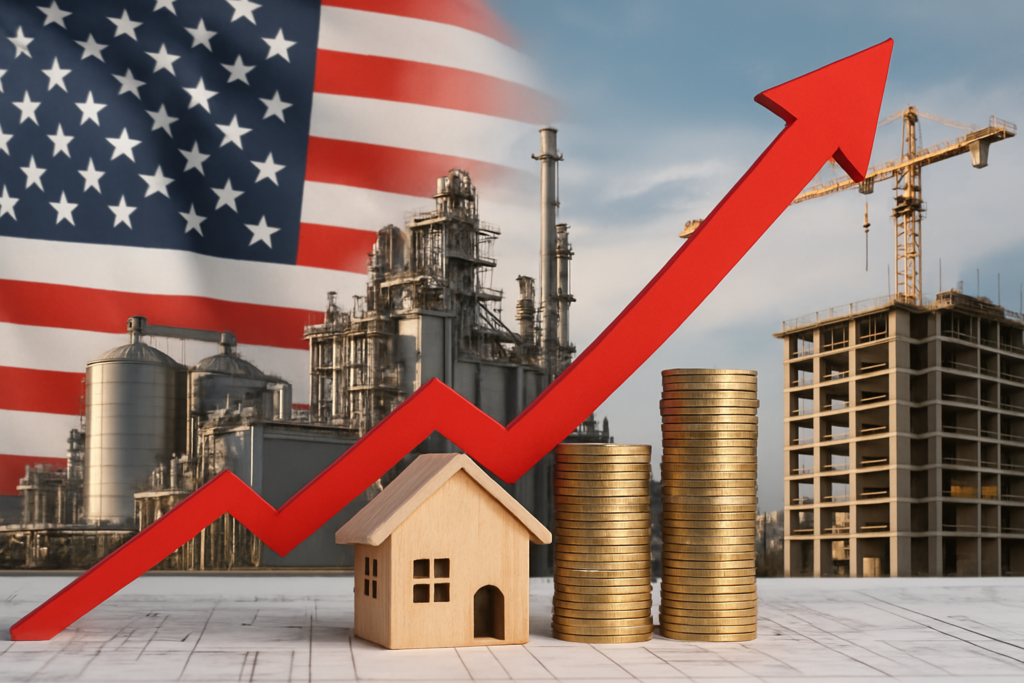As tariffs and trade policy continue to make headlines in 2025, commercial real estate investors and industry professionals are closely watching the ripple effects across the U.S. economy. In the recent panel discussion, 2025 Real Estate Market Outlook: Market Trends, Policy Shifts, and Investment Strategies, hosted by Tempo Family of Funds & Syndications, experts from across the real estate and finance sectors explored how tariffs are shaping production trends, asset values, and investment opportunities. A key takeaway: tariffs are driving more production back to the United States, with significant benefits for domestic industries and the broader real estate market.
Tariffs and the Shift Toward U.S. Production
One compelling insight from the panel came from Neal Bawa, CEO / Founder at Mission10K and Grocapitus. Bawa highlighted that, despite concerns about supply chain disruptions and increased costs, tariffs are accelerating a trend that was already underway: the reshoring of production to the United States. Neal explains that the U.S. is still a major industrial producer, with about 70% of materials for housing construction sourced domestically. While the U.S. makes up about 4% of the world’s population, it accounts for roughly 17% of global industrial output. However, it is important to note that the U.S. once produced around 25% of the world’s industrial goods in the early 2000s. So, while we remain an industrial giant, our share has declined as other nations have expanded their manufacturing sectors.
What we’re seeing is an incremental push, as tariffs are making it even more attractive to keep and expand manufacturing here in the United States. This statistic highlights an important takeaway for investors and policymakers—most U.S. manufacturing capacity is already domestic, and recent policy changes are reinforcing this foundation rather than radically altering it.
Benefits for U.S. Industries and Real Estate
Increased domestic production offers several positive outcomes:
- Job Creation: Expanding U.S. manufacturing means more jobs, both in factories and across related sectors such as logistics, construction, and services.
- Supply Chain Resilience: By reducing reliance on overseas suppliers, U.S. companies can better weather global disruptions, from geopolitical tensions to natural disasters.
- Increased Demand for Industrial Real Estate: As companies expand or build new facilities, demand for warehouses, factories, and distribution centers rises, driving growth in the industrial and self-storage sectors.
These advantages not only strengthen the nation’s economic foundation but also create meaningful opportunities for growth and innovation across multiple sectors.
A Stable Foundation for Investors
For investors, the trend toward more U.S.-based production means greater stability and long-term opportunity. As Bawa pointed out, the U.S. is already a dominant player in production, and these policies are just reinforcing that position. This stability is especially attractive in uncertain economic times, offering a hedge against global volatility and shifting trade dynamics.
Now Is the Time for Deep Value Buys
Mike Zlotnik, CEO of Tempo Family of Funds & Syndications, explained that the current market environment presents unique opportunities for investors willing to act decisively. He noted that, as the market has shifted, there has been a significant reset in asset values, creating what he describes as a historically strong moment for deep value investments. By closely monitoring key metrics such as reconstruction costs and the spread between cap rates and interest rates, Zlotnik believes now is an excellent time to deploy fresh capital. He emphasized that uncertainty in the market often leads to the best opportunities, like Warren Buffett says, “The time to buy is when there’s blood in the streets.” As more companies choose to manufacture and distribute goods domestically, the demand for high-quality real estate will only continue to grow.
Final Thoughts
Tariffs are more than just a political talking point—they are actively shaping the landscape of U.S. production and real estate investment. For investors, today’s market presents many opportunities. Tariffs have contributed to sectoral shifts, driving demand for industrial and commercial real estate, even as they may introduce some higher costs in other areas. This environment rewards those who recognize the enduring value of domestic production and are prepared to act when market resets create deep value opportunities. As the U.S. continues to adapt and grow, the intersection of trade policy, production, and real estate will remain a course of long-term growth for those who stay informed. As always, Tempo is committed to helping investors navigate these shifts with insight, expertise, and a data-driven focus on long-term value.

